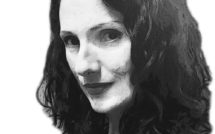

Like Hansel and Gretel, we follow a path.
If we were really Hansel and Gretel, we’d walk through wolf-filled woods, the sky dark, a bright moon overhead. Here, we wander amid a bright thicket of beds and dressers, desks and chairs.
There are arrows painted on the floor, but these feel unnecessary. Most everyone in the Ikea showroom stays on the path, an amiable herd only aware we are walking together when someone comes at us the wrong way.
We walk past room after room. There are pretend television sets, of course. But unlike in other furniture stores, the unseen inhabitants of these imaginary rooms read books—they are stacked on coffee tables, jammed into bookshelves, left open on the arms of chairs. There is art in the Ikea living room, too, evidence of life lived. Bedrooms, kitchens, and bathrooms are dusted with reality. Look, the children have left their toys in the corner! A beautifully cut suit (not for sale) hangs in the smart, career-woman closet, her empty shoes lined up just so.
The rooms are real and yet not, like life-sized dollhouses. They are just slightly uncanny. Empty yet filled with clues about lives interrupted, they are like the Three Bears’ cottage when Goldilocks enters, and I walk through them like Goldilocks, covetous but a little guilty about it. Although I tell my young son to look with his eyes, not with his hands, I confess I do both. I touch it all.
As a child, I loved fairy tales. The book I adored most was big and blue, old even before my father grew up on it and quite battered by the time it came to my brothers and me. As ancient as it seemed to me then, it was a baby compared to the stories inside—scholars now say that many of the tales predate, in their oral form, the development of the languages in which they were first written down.
Fairy tales are at once eternal and endlessly renewable. Everything that happens in them—trickery and deception, transgression and harsh justice, magic and danger and love—evokes something of what childhood is like, or really, what life is like. We may never face a witch or bear, but every one of us learned as kids how it feels to lie, pretend to be someone else, or outsmart somebody bigger and stronger.
My mother tossed it out, that beloved blue book, after a flooded basement waterlogged it. Those years that I imagined myself lost in the woods or hiding from a witch, our mother was drowning in depression, occasionally erupting into mania. I wanted to be as self-sufficient as Hansel and Gretel, whose abandonment by their parents terrified but did not shock me. I yearned to believe that at the end of scary journeys, there would be safe homecomings, that fairy godmothers could divine our good intentions, that children do triumph, even when their families go wrong.
When I was the age my son is now, I built little houses wherever I could: out of shoeboxes in my closet, out of twigs and stones in the yard. My mother once told me that as a toddler, I liked to group everything in threes: mama, daddy, child. I’m still comforted by certainty and order. I can’t know if it’s because my mother was erratic and our house often chaotic, but I’ve grown into the kind of person who likes things simple: no secrets, no hidden dangers, a clearly marked path to follow. I’m impatient, but I can wait forever for the other shoe to drop.
At Ikea, though, I always feel as if nothing bad can happen. All those tidy little rooms, like a happy house whose family has just stepped out. As if a kind of enchantment is at work.
I know not everyone feels the same way. You can spot the resisters: they grumble about the pathway—they want to choose their own path! Marital arguments sometimes erupt during Ikea shopping, or during the assembly of furniture back at home. Once, in an Ikea outside Boston, I found myself walking behind a couple through the forest of beds. They began squabbling, and as their voices rose and arms began wheeling, I realized they were two distinguished professors of literature, an unmarried couple well known in the department where I worked as a secretary.
The scene reminded me of another fairy tale in the big blue book—“Toads and Diamonds”—in which a spoiled young woman meets a fairy godmother disguised as an old beggar. The fairy godmother asks for help drawing water from the well; when the girl refuses, she becomes cursed: every time she opens her mouth to speak, frogs and lizards slither out. The story fascinated and chastened me. I knew my mother felt I talked too much, was difficult, was not kind. Secretly, I thought of myself as the sort of person who would be sweet to an old beggar, but I knew my mother wished I were sweeter to her.
The literature professors spat amphibians at one another all through the bedrooms, then vanished as they stepped off the path. I stayed on, my mouth shut tight.
Later, at an Ikea in Atlanta, I watched a group of expensively dressed, well-coiffed women marvel at each of the tiny apartment layouts we came upon. “I live in 590 square feet” was painted on the wall of one. “I live in 380 square feet”, “I live in 240 square feet.” My New York and Boston friends lament their cramped apartments, yearning for room to spread out. I saw a different kind of longing in the eyes of these women as they took in the tidiness and tininess of these spaces, like playhouses loved in girlhood. As I imagined it, instead of daydreaming a future life, they were wondering what it would be like to have a different one, solitary and self-contained, no vast, suburban, carpeted expanses to vacuum.
I know it’s just a store—I leave my money behind and take things home—but sometimes I’m so powerfully enthralled, I don’t remember what I’ve bought until I pull things out of bags. Ikea’s enchantment lies in the multiple realities it suggests, the idea that any kind of home, or life, could be within reach.
What if the path went that way instead of this? What if instead of insulting that beggar woman, you filled her bucket? In the fairy tale, the vain young woman’s kinder sister helped the disguised fairy godmother, and instead of frogs and lizards, diamonds and pearls fell from that girl’s mouth.
In the Hansel and Gretel story’s earliest form, the children’s mother and father abandon them in the forest because there isn’t enough food to feed them (in later versions, the mother is replaced by a stepmother). The children yearn to get home, but the reader knows home is not any safer than the forest. Still, Hansel and Gretel are desperate to return. They refuse to stay in the forest and starve; they refuse to be killed and eaten by the witch. That they deserve to live is never in doubt—just as the fact that their parents want to kill them is never examined—and when they finally do make it home, their father has come to his senses and their stepmother, or mother, is gone.
As a child, I could never figure out what I was supposed to learn from “Hansel and Gretel.” I understood that “Toads and Diamonds” had a lesson for me, just as “Beauty and the Beast” did (although I remained confused about why anyone would prefer the boring prince to the wonderful beast). But beyond their cleverness and will to survive, what could Hansel and Gretel teach me? Wasn’t the moral of that story better aimed at parents? Don’t abandon your children—you will regret it or be punished for it. Or maybe the story of Hansel and Gretel is itself a little bread-crumbed path, a line of clues laid out in childhood that you don’t notice until you’re grown:
Once upon a time, you were a child. But you survived. Someday, you will grow up and make your own home. It will be what you always wanted it to be—the children’s toys in the corner, the book open upon a chair.

Photographic response by Sanja Vrzić
Kate Tuttle is a writer based in New Jersey. She is a book columnist for the Boston Globe; her reviews, profiles, and essays have also appeared in the Los Angeles Times, Washington Post, New York Times, Salon, and The Rumpus. Visit katetuttle.net to read her work on books and authors, race and politics, family and childhood. She is currently serving as president of the National Book Critics Circle.
Sanja Vrzić is an architect, photographer, and graphic designer. She was born in Sarajevo, where she completed a degree in architecture in 2010. Since then, she has worked as a freelancer in Sarajevo, Paris, and Nice. Her expertise is in landscape, documentary, and cultural photography.
Published on November 2, 2017.
Click here to read more on The Borders Project.




